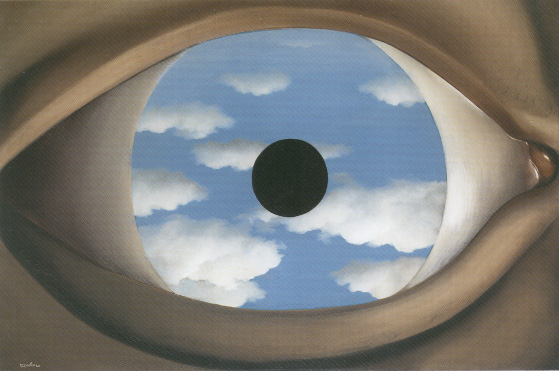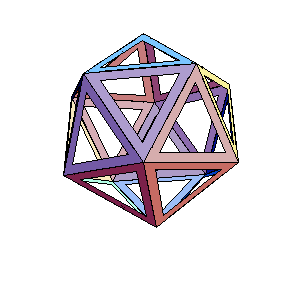


"The operations of things made by skill are, for the most part, performed by apparatus large enough to be easily perceived by the senses for this is necessary so that they can be made by men. On the other hand, however, natural effects always depend on some devices so minute that they escape all senses."
Rene Descartes, 1644.
The sense of sight in both literal and figurative expression is too fundamental for us not to analyze in some detail.
"Descartes was aware that demonstration by mechanical analogy could be taken too literally–that the contrivance itself could all too easily be seen as constituting proof of what is actually happening. This was a trap into which many predecessors and contemporaries had fallen. Even for a philosopher who thought to explain all aspects of the physical world in terms of the action of matter on matter, illustration by mechanical analogy was a limited device. Accordingly he scolded those who viewed his vivid aids to visualization in too obvious a way: 'I did not say that light was extended like a stick, but like the actions or movements transmitted by a stick.'
The blind man probing with sticks simply helps us to understand how vision might work in terms of underlying properties of things in action."
"A number of his visual conceptions, such as his analysis of binocular vision and the inverted image on the retina in terms of a blind man with a pair of sticks, became oft-repeated classics."
Kemp, Visualizations, pp. 38-39.
Illustration: "in a way that words cannot emulate."
Because illustration is based on what we can see, how do we understand the means by which our eyes deceive us?
trompe-l'oeil, optical illusions, & visual thinking as analogs.
Mirage – a capacity to see something that is actually not present.
- trompe-l'oeil, literally to "fool the eye" it figuratively referees to the illusion of a perspective not actually there. Because the three dimensions appear to be in a two-dimensional plane, we say the painting fools the eyes.
- optical illusions, perception is a jealous master and we are the children of "sight-driven" creatures who since our ancestral cousins' predecessors and our parental lines were arboreal mammals became so dependent on sight as opposed to smell. We humans assume the world is a visual area in which we play, stalk, and seek security. Well, that is less than half the story of reality and the actual conditions in which we dwell.
visual thinking
"the ability to find meaning in imagery"
Some recognition that the apparatus of the eye performs certain tasks that one could call more than merely perceptual representations and attribute cognitive features to the the eye's capacity to interpret and translate order, size and distance relationships, and shading into meaningful signals that are then transmitted from the optical apparatus to the visual cortex.
Starting from the literal to the metaphorical level and leading to the aesthetic escape level.
"The clarification of visual forms and their organization in integrated patterns as well as the attribution of such forms to suitable objects is one of the most effective training grounds of the young mind."
"all perceiving is also thinking, all reasoning is also intuition, all observation is also invention" (1974).
Arnheim challenged the accepted wisdom that words, as opposed to images, are the basic aspects of thinking, to the extent that language precedes perception.
He suggested that perception is a form of cognition, that is to say mental action.
Arnheim argued, "the remarkable mechanisms by which the senses understand the environment are all but identical with the operations described by the psychology of thinking" (1969).
Much like rational or scientific discovery, he suggested that, artistic expression "is a form of reasoning, in which perceiving and thinking are indivisibly intertwined. A person who paints, writes, composes, dances, I felt compelled to say, thinks with his senses" (1969).
“Shape perception operates at a high cognitive level of concept formation” (29).
Arnheim took pains to describe the way that images are interpreted only in a context, “Things fit together by assimilation and contrast” (65).
“To lift something out of its context means to neglect an important aspect of its nature” (71).
Arnheim begins this work by placing his ideas within the structure of Western philosophy, that is, the dichotomy between rationalism (Plato) and empiricism (Aristotle). He comes down strongly on the side of the empiricist and writes:
Aristotle asserts that an object is real to us through its true and lasting nature, not through its changeable properties. Its universal character is directly perceived in it as its essence rather than indirectly collected through the search of common elements .
In his essay Film as Art, Rudolf Arnheim sets out to refute the claim that
“Film cannot be art, for it does nothing but reproduce reality mechanically”.1
What are analogs?
In the example of an electronic devise an analog signal contains information using no quantized variances in frequency and amplitude.
This means that in photography the recording (as opposed to digital) is done by copying the image seen with film.
A chemical property with similar attributes such as in biochemical processes one may be substituted for the other; for example calcium can be replaced by strontium.
An analogy is a comparison, some proportional reference of one thing to a similar or contrasting thing.
An analog is something comparable, Aristotle used analogies as a means of instructing readers about appropriate and inappropriate categories of experience to compare.
A significant analog of incomparable qualities that we perceive according to Martin Heidegger, are:
Earth and Sky are to one another as mortals (finite) & immortals (infinities).
Sources:
ARNHEIM, Rudolph, Film as Art, (1957), p. 8.
ARNHEIM, R. Art and Visual Perception, ( Berkeley: University of California Press, 1954 ).
ARNHEIM, R. Visual Thinking, ( Berkeley: University of California Press, 1969 ). NYPL
"Rudolf Arnheim has not only shown us how wrong that [Freud] is, he has parsed the grammar of form with uncanny acuity and taught us how to read it. Few books continue to speak to the generations after them; Visual Thinking is one of those rare exceptions."
Wilde, Oscar. The Decay of Lying in Intentions (1891).
Jonathan Fineberg, author of Art Since 1940.
Edward Hopper – Gas, 1940
Edward Hopper – Night Hawks, 1942.
Joseph Mallord William Turner – Rain, Speed and Steam, 1844.
John Constable – Flatford Mill, 1816-17.
Frederic Edwin Church – paintings, 1845-1900.
Thomas Cole – paintings, 1824-1840.

